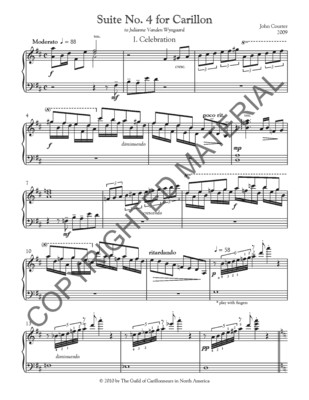
[PDF] Suite No. 4 for Carillon
Movements
- Celebration
- Chanson triste
- Toccata festiva
Program notes
The opening movement, "Celebration," passes through many moods right from the start. A particularly interesting playing technique employed in this introductory section is a series of rapid, but soft, scales, which he suggests be played with individual fingers on the keys, rather than the usual loose fists. (Just how well that technique works depends on the carillon involved.) A series of contrasting themes are presented and developed somewhat, suggestive of a sonata form but freer in structure. The first of those themes returns in the final section, bringing the work to an appropriately joyous close. The second movement, "Chanson triste" (Sad Song—sounds a little better in the French), is a slowish, waltz-like piece, with the main theme, though somewhat songlike, being quite chromatic. A contrasting middle section is a bit more animated, with a sweeter melody in a major key. After the return of the first theme, the final section features a brilliant flourish that runs up to the higher ranges of the carillon and back. The final movement, "Toccata festiva," is in a cheerful major sonority again. Both the melody and the accompanying figuration at the beginning section are predominantly pentatonic (the same scale one would arrive at by playing only on the black keys of a piano). A second theme, somewhat jaunty in its rhythm, serves as an effective foil to the first section. In the course of that section, several modes are explored (major key sonorities, with slight adjustments to certain notes). The return of the opening section brings the movement, and the suite overall, to an appropriately bright conclusion.
—The GCNA
![[PDF] Suite No. 4 for Carillon [PDF] Suite No. 4 for Carillon](https://d2j6dbq0eux0bg.cloudfront.net/images/9481258/984529302.jpg)
